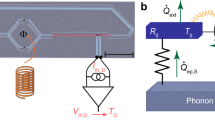Abstract
A model for the quantum measurement of the electronic current in a Josephson junction is presented and analyzed. The model is similar to a Stern-Gerlach apparatus, relying on the deflection of a spin-polarized particle beam by the magnetic field created by the Josephson current. The aim is (1) to explore, with the help of a simple model, some general ideas about the nature of the information which can be obtained by measurements upon a quantum system and (2) to find new approaches for obtaining information about the nature of the states of a macroscopic quantum system. In the case of sufficiently strong coupling between the system and the apparatus, we find that the model provides in principle a standard ideal measurement of the value of the instantaneous Josephson current. In the case of weak coupling, where the measurement is not ideal, we show that the scattering of neutrons from a junction can in principle be used to measure the average value of the Josephson current, thereby allowing an experimental distinction to be made between an eigenstate of relative phase and one of relative Cooper pair number. The possibility of the latter type of measurement suggests an experimental approach to answer a question of fundamental interest, namely whether two isolated superconductors (or superfluids) possess a definite relative phase or a definite relative number of superconducting (or super/lowing) particles.
Similar content being viewed by others
References
For a collection of fundamental papers, seeQuantum Theory and Measurement, J. A. Wheeler and W. H. Zurek, eds. (Princeton University Press, Princeton, 1983).
A. J. Leggett,Contemp. Phys. 25, 583 (1984).
A. O. Caldeira and A. J. Leggett,Ann. Phys. (N. Y.) (1983); A. J. Leggett, inChance and Matter (Proceedings of Les Houches, Session XLVI, 1986), J. Souletie, J. Vannimenus, and R. Stora, eds. (Elsevier, Amsterdam, 1987).
P. W. Anderson,Phys. Rev. 112, 164 (1958);Rev. Mod. Phys. 38, 298 (1966).
P. W. Anderson, inThe Lesson of Quantum Theory, J. de Boer, E. Dal, and O. Ulfbeck, eds. (North-Holland, Amsterdam, 1986).
A. J. Leggett and F. Sols,Found. Phys. 21, 353 (1991).
D. Bohm,Quantum Theory (Prentice-Hall, New York, 1951; reprinted by Dover, New York, 1989).
E. P. Wigner,Am. J. Phys. 31, 6 (1963).
M. Hillery and M. O. Scully, inQuantum Optics, Experimental Gravity, and Measurement Theory, P. Meystre and M. O. Scully, eds. (Plenum, New York, 1983).
M. O. Scully, B. G. Englert, and J. Schwinger,Phys. Rev. A 40, 1775 (1989).
L. E. Ballentine,Phys. Rev. A 43, 5165 (1991).
A. Peres,Phys. Rev. D 39, 2943 (1989).
A. Peres and A. Ron,Phys. Rev. A 42, 5720 (1990).
C. Caves, inQuantum Optics, Experimental Gravity, and Measurement Theory, P. Meystre and M. O. Scully, eds. (Plenum, New York and London, 1983).
T. Van Duzer and C. W. Turner,Principles of Superconductors Devices and Circuits (North Holland, Amsterdam, 1981), pp. 150, 160–162; P. W. Anderson, inLectures on the Many-Body Problem (Ravello, 1963), E. R. Caianiello, ed., Vol. 2 (Academic, New York, 1964), pp. 113–135, especially p. 127.
N. F. Mott and H. S. W. Massey,The Theory of Atomic Collisions (Clarendon Press, Oxford, 1965), pp. 214–219.
J. R. Taylor,Scattering Theory (Wiley, New York, 1972).
P. W. Anderson,Basic Notions of Condensed Matter Physics (Benjamin/Cummings, Menlo Park, 1984).
B. D'Espagnat,Conceptual Foundations of Quantum Mechanics (Addison-Wesley, Menlo Park, 1989), Chap. 10.
F. Sols,Physica B 194–196, 1389 (1994); F. Sols and R. A. Hegstrom, inFundamental Problems in Quantum Physics, by M. Ferrero and A. van der Merwe, eds. (Kluwer Academic, Dordrecht, 1995).
L. S. Rodberg and R. M. Thaler,Introduction to the Quantum Theory of Scattering (Academic Press, New York, 1967), p. 17.
D. K. Saldin and P. L. de Andres,Phys. Rev. Lett. 64, 1270 (1990).
A. Szöke, inShort Wavelength Coherent Radiation: Generalization and Application, by D. J. Atwood and J. Boker, eds. (AIP Conference Proceedings No. 147) (American Institute of Physics, New York, 1986).
Y. Aharonov, J. Anandan, and L. Vaidman,Phys. Rev. A 47, 4616 (1993).
Y. Aharonov and L. Vaidman,Phys. Lett. A 178, 38 (1993).
Author information
Authors and Affiliations
Rights and permissions
About this article
Cite this article
Hegstrom, R.A., Sols, F. A model of quantum measurement in Josephson junctions. Found Phys 25, 681–700 (1995). https://doi.org/10.1007/BF02059123
Received:
Revised:
Issue Date:
DOI: https://doi.org/10.1007/BF02059123



